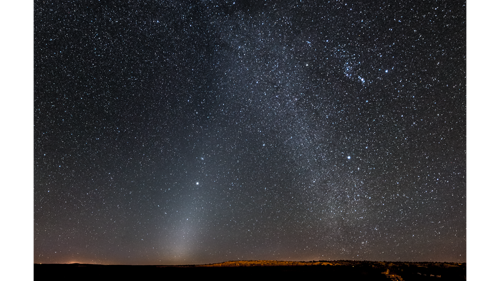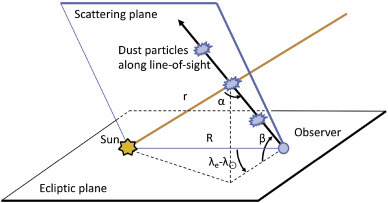The night sky has always fascinated humanity, inviting us to ponder the mysteries of the universe and inspiring awe-inspiring tales of constellations and celestial events. Among the countless wonders that adorn the heavens, one ethereal phenomenon, known as Zodiacal Light, captivates the hearts and minds of stargazers and astronomers alike. Illuminating the dark canvas of the night, this celestial spectacle reveals a radiant glow that spans across the sky, beckoning us to explore its enigmatic origins and beguiling nature.
In this blog post, we embark on a celestial journey to understand the essence of Zodiacal Light. From its definition and appearances to its scientific explanation and cultural significance, we will unravel the secrets behind this celestial phenomenon. Join us as we immerse ourselves in the captivating beauty of the zodiacal light, an enchanting spectacle that unveils the wonders of our universe.
What is Zodiacal Light?
Zodiacal Light refers to a faint glow that appears as a triangular-shaped band of light stretching along the ecliptic, the path of the Sun across the sky as seen from Earth. This ethereal illumination is most prominently visible after sunset or before sunrise, emanating from the horizon and extending upwards in a cone-like shape. Often mistaken for the Milky Way or a distant city's lights, Zodiacal Light possesses its own unique characteristics and origins.

Origins and Appearances:
The origin of Zodiacal Light can be traced back to the interplanetary dust scattered throughout our solar system. Tiny particles, remnants of comets, asteroid collisions, and the disintegration of interplanetary debris, are the primary constituents of this cosmic dust cloud. As sunlight passes through this cloud, it scatters and reflects off the particles, giving rise to the luminous phenomenon we observe.
Zodiacal Light is typically observed under specific conditions. Away from sources of light pollution, in regions with clear skies and minimal atmospheric interference, one can catch a glimpse of this ethereal glow. The best opportunities for observation occur during spring in the Northern Hemisphere and autumn in the Southern Hemisphere when the ecliptic plane is tilted at an angle to the horizon, creating optimal viewing conditions.
Moreover, Zodiacal Light can appear in two distinct forms: the evening Zodiacal Light and the morning Zodiacal Light. The evening Zodiacal Light is visible after sunset, stretching upwards from the horizon in the western sky, while the morning Zodiacal Light can be observed before sunrise, emanating from the eastern horizon. Both manifestations share a common trait – a cone-shaped glow that gradually fades into the dark sky as it ascends.
Scientific Explanation:
The scientific explanation behind the phenomenon of Zodiacal Light lies in the interplay between sunlight and the interplanetary dust particles. As sunlight travels through space, it encounters these tiny particles, ranging in size from micrometers to millimeters, suspended along the ecliptic plane. The light undergoes scattering when it encounters the particles, deviating from its path and illuminating the surrounding area.

There are several factors that contribute to the luminosity of Zodiacal Light. The size and distribution of the dust particles, as well as their composition, influence the intensity and color of the scattered light. Additionally, the geometry of the solar system
plays a role in the appearance of Zodiacal Light. The tilt of Earth's axis and its orbit around the Sun create the changing angles at which sunlight interacts with the dust particles, resulting in variations in the visibility and intensity of Zodiacal Light throughout the year.
The interplanetary dust cloud responsible for Zodiacal Light is most concentrated near the plane of the solar system, which coincides with the ecliptic. This is why the phenomenon appears as a band of light along the same path that the Sun and planets appear to traverse across the sky. The shape of the Zodiacal Light cone is determined by the angle at which the sunlight scatters off the dust particles and the observer's location on Earth.
While Zodiacal Light itself is a breathtaking sight, its presence also has important implications for astronomical observations. The dust particles that give rise to this phenomenon can affect the visibility of celestial objects by scattering and absorbing starlight. Astronomers must consider the impact of Zodiacal Light when observing faint objects in the night sky, particularly in the regions near the ecliptic.
Cultural Significance:
Zodiacal Light has been observed and recognized by various civilizations throughout history, leading to cultural interpretations and associations. In ancient times, this celestial glow was often linked to mythical and religious beliefs. For example, the ancient Egyptians associated Zodiacal Light with the god Horus, the falcon-headed deity representing the sky and celestial realms. In Greek mythology, it was seen as a celestial pathway traveled by the goddess Eos, the personification of dawn.
Furthermore, Zodiacal Light has played a role in astrological traditions. The Zodiac, a belt of constellations along the ecliptic, derives its name from the phenomenon. Astrologers believe that the position of celestial bodies along the ecliptic at the time of one's birth influences their personality traits and future events. Zodiacal Light, being intimately connected to the ecliptic, holds symbolic significance in astrology as a celestial bridge between the terrestrial and divine realms.
Observing Zodiacal Light:
To witness the mesmerizing beauty of Zodiacal Light, one must venture to a location with dark skies, away from the glare of city lights. The absence of light pollution allows for optimal visibility of this celestial phenomenon. Additionally, choosing a time when the ecliptic is tilted at an angle to the horizon, such as during spring or autumn, enhances the chances of witnessing Zodiacal Light.
Preparation is key when observing Zodiacal Light. Arrive at your chosen location before twilight to allow your eyes to adjust to the darkness. Find a spot with an unobstructed view of the horizon, as the glow will initially appear near the horizon and extend upwards. Patience is essential, as Zodiacal Light may take some time to become fully visible as the sky darkens.
It is advisable to bring a pair of binoculars or a small telescope to enhance your viewing experience. While Zodiacal Light is visible to the naked eye, these optical aids can help you discern finer details and appreciate the delicate structure of the phenomenon. Capture the moment with a camera capable of long-exposure photography to immortalize the ethereal beauty of Zodiacal Light.
When it comes to observing Zodiacal Light, finding a location with minimal light pollution and optimal viewing conditions is key. Here are some of the best places around the world known for their dark skies and excellent opportunities to witness this celestial phenomenon:
Experience Zodiacal Light Here:
- Ladakh, India: Nestled in the Himalayas, Ladakh offers clear skies and high-altitude locations, making it an excellent spot for stargazing. The region's remote and rugged landscapes provide minimal light pollution, allowing for optimal Zodiacal Light viewing.
-
Atacama Desert, Chile: Known for its incredibly clear and dark skies, the Atacama Desert offers ideal conditions for stargazing and observing Zodiacal Light. The region is home to various observatories and is renowned among astronomers and astrophotographers.
-
Mauna Kea, Hawaii, USA: Located on the Big Island of Hawaii, Mauna Kea is renowned for its high altitude and clear skies. With its minimal light pollution and excellent atmospheric conditions, it provides a fantastic vantage point for observing celestial phenomena like Zodiacal Light.
-
Tenerife, Canary Islands, Spain: The Canary Islands, particularly Tenerife, have become popular destinations for astrotourism due to their dark skies and preservation of astronomical heritage. Mount Teide, the highest peak in Spain, offers breathtaking views of the night sky and is an excellent spot for witnessing Zodiacal Light.
-
NamibRand Nature Reserve, Namibia: This vast desert reserve in Namibia boasts exceptionally dark skies and limited light pollution, making it an ideal location for stargazing and Zodiacal Light observation. The contrasting landscapes of sand dunes and the night sky create a magical atmosphere.
-
Aoraki Mackenzie Dark Sky Reserve, New Zealand: Situated in the South Island of New Zealand, this dark sky reserve is known for its pristine night skies and stunning landscapes. The reserve provides a protected environment for stargazing enthusiasts and offers excellent conditions for observing Zodiacal Light.
-
Death Valley National Park, California, USA: With its vast desert landscapes and remote locations, Death Valley National Park offers incredible opportunities for stargazing and observing Zodiacal Light. The park has designated Dark Sky Places that provide optimal conditions for night sky viewing.
-
Isle of Sark, Channel Islands: The Isle of Sark, a small island in the English Channel, has limited light pollution due to strict regulations on artificial lighting. As a result, the island offers remarkably clear and dark skies, making it an ideal destination for experiencing Zodiacal Light.
-
Rishiri Island, Japan: Located off the coast of Hokkaido, Rishiri Island is known for its pristine natural beauty and dark skies. With its isolated location and limited light pollution, it provides a wonderful setting for observing Zodiacal Light.
-
Mount Bromo, Indonesia: Situated in East Java, Mount Bromo is a popular destination for both adventure and stargazing enthusiasts. Its volcanic landscapes and clear skies create a surreal backdrop for witnessing Zodiacal Light.
-
Bortala Mongol Autonomous Prefecture, China: Located in Xinjiang province, this region in northwest China offers vast stretches of uninhabited land and minimal light pollution. The sparsely populated areas provide excellent conditions for observing celestial phenomena like Zodiacal Light.
-
Chiang Mai, Thailand: While Chiang Mai is known for its cultural heritage, it also offers opportunities for stargazing and Zodiacal Light observation. Venturing outside the city into the rural areas provides darker skies and a better chance to witness this celestial phenomenon.
-
Bagan, Myanmar: Known for its ancient temples and pagodas, Bagan also offers stunning night skies for stargazers. Away from the urban centers, you can find areas with less light pollution, providing clearer views of Zodiacal Light.
-
Gobi Desert, Mongolia: Mongolia's Gobi Desert is renowned for its vastness and remoteness. With minimal light pollution and a wide-open sky, it serves as an exceptional location for observing Zodiacal Light and other astronomical wonders.
- Isle of Sark, Channel Islands, United Kingdom: The Isle of Sark is a small island located in the English Channel, known for its pristine natural beauty and dark skies. The island has limited light pollution due to strict regulations on artificial lighting, making it an ideal destination for stargazing and observing Zodiacal Light. The absence of light pollution allows for excellent visibility of celestial objects, including the ethereal glow of Zodiacal Light.
-
Tenerife, Canary Islands, Spain: The Canary Islands, particularly Tenerife, are renowned for their dark skies and excellent conditions for stargazing. Mount Teide, Spain's highest peak, offers an elevated vantage point for observing Zodiacal Light. The island's dedication to preserving its astronomical heritage and the establishment of designated stargazing sites make Tenerife an ideal destination for experiencing this celestial phenomenon.
-
Abisko National Park, Sweden: Located within the Arctic Circle, Abisko National Park is known for its pristine wilderness and remarkably clear skies. Its remote location and minimal light pollution create ideal conditions for observing Zodiacal Light. The park's Aurora Sky Station, situated on Mount Nuolja, provides panoramic views of the night sky and offers visitors a chance to witness the mesmerizing glow of Zodiacal Light.
-
Wadi Rum, Jordan: Wadi Rum, also known as the Valley of the Moon, is a desert region renowned for its otherworldly landscapes and dark skies. With its remote location and minimal light pollution, it offers a captivating setting for stargazing and observing Zodiacal Light. Immerse yourself in the vast desert vistas and witness the celestial glow that adds an ethereal touch to the magical surroundings.
-
Wadi Bani Khalid, Oman: Situated in the eastern region of Oman, Wadi Bani Khalid is known for its stunning desert oasis and tranquil surroundings. Away from city lights, this remote location offers pristine night skies, making it an excellent spot for experiencing Zodiacal Light. Enjoy the serene atmosphere and marvel at the interplay of light and dust particles as you witness this celestial spectacle.
- Denali National Park: Located in the heart of Alaska, Denali National Park is known for its pristine landscapes, towering mountains, and dark skies. The park offers vast areas with minimal light pollution, making it an ideal destination for stargazing and witnessing Zodiacal Light. The wide-open spaces and breathtaking views provide a perfect setting for immersing yourself in the wonders of the night sky.
Conclusion:
Zodiacal Light, a celestial phenomenon born from the interplay of sunlight and interplanetary dust particles, enchants and mystifies observers worldwide. Its triangular glow along the ecliptic evokes a sense of wonder and awe, connecting us to the vastness of the universe. By understanding the origins, appearances, and scientific explanation of Zodiacal Light, we deepen our appreciation for the cosmic wonders that adorn our night skies.
As we gaze upon this ethereal phenomenon, we are reminded of the profound relationship between Earth and the cosmos. Zodiacal Light reveals the intricate dance of celestial bodies and the ever-present cosmic dust that permeates our solar system. It serves as a reminder of our place in the universe and the interconnectedness of all celestial phenomena.
Zodiacal Light not only offers a visual spectacle but also carries cultural and symbolic significance. From ancient mythologies to astrological beliefs, it has inspired human imagination and shaped our understanding of the celestial realm. Its presence in our night sky adds a touch of enchantment and invites us to contemplate our connection to the cosmos.
To experience the beauty of Zodiacal Light firsthand, it is crucial to seek out dark sky locations and favorable viewing conditions. Patiently waiting for the right moment, one can witness the gradual emergence of the luminous cone, reaching upward from the horizon. Armed with binoculars or a telescope, observers can explore the intricate details and delicate structure of this celestial phenomenon.
Zodiacal Light serves as a reminder that there is always more to discover and explore in the vast expanse of the universe. Its ethereal glow beckons us to delve deeper into the mysteries of the cosmos, igniting a sense of curiosity and wonder. By embracing the wonders of Zodiacal Light, we embark on a celestial journey that expands our knowledge and deepens our appreciation for the beauty that lies beyond our earthly realm.
So, the next time you find yourself beneath a dark, star-studded sky, take a moment to gaze upon the radiant glow of Zodiacal Light. Let it transport you to the realms beyond, where cosmic dust particles dance with sunlight, revealing the extraordinary beauty that resides in the depths of our universe. In the enchanting embrace of Zodiacal Light, we discover that the night sky holds timeless wonders, waiting to be explored and cherished.
As we conclude our exploration of Zodiacal Light, let us carry the memory of its celestial glow with us, reminding us of the beauty and vastness that lie above. The next time you look up at the night sky, remember to seek out the gentle radiance of Zodiacal Light and allow yourself to be captivated by its celestial dance.
Discover More
Most Viewed
Nature never ceases to amaze us with its breathtaking beauty and natural phenomena. In this blog, we highlight ten fascinating natural events that attract travelers from around the world.
Read More

















